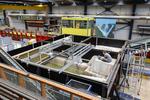Other

“EPFL researchers have combined low-power chip design, machine learning algorithms, and soft implantable electrodes to produce a neural interface that can identify and suppress symptoms of various neurological disorders. Mahsa Shoaran of the Integrated Neurotechnologies Laboratory in the School of …

“EPFL researchers have collaborated with those at Harvard and ETH Zurich on a new thin-film circuit that, when connected to a laser beam, produces finely tailorable terahertz-frequency waves. The device opens up a world of potential applications in optics and …

“Scientists at EPFL and Heriot-Watt University have developed a machine learning approach to accurately predict potentially harmful amine emissions from carbon-capturing plants. Global warming is partly due to the vast amount of carbon dioxide that we release, mostly from power …

“Scientists at EPFL have found a way to improve the operational stability of perovskite solar cells, a crucial step towards their commercialization. Hybrid perovskites are materials made from metal halide frameworks interspersed with organic cations. They have attracted a lot …

“A team of scientists at EPFL have built a new neural network system that can help understand how animals adapt their movement to changes in their own body and to create more powerful artificial intelligence systems. Deep learning has been …

“Scientists at EPFL have developed photonic integrated circuits that demonstrated a new principle of light amplification on a silicon chip. It can be employed for optical signals like those used in Lidar, trans-oceanic fiber amplifiers or in data center telecommunications …

“In Switzerland, tire and road wear particles are one of the biggest sources of microplastics released into the environment, yet the chemical compounds contained in those particles – and their effects – remain largely a mystery. To remedy that knowledge gap, scientists …

“Scientists at EPFL have increased the power conversion efficiency of dye-sensitized solar cells (“Grätzel cells”) beyond 15% in direct sunlight and 30% in ambient light conditions. Mesoscopic dye-sensitized solar cells (DSCs) were invented in 1990s by Brian O’Regan and …

“EPFL scientists have developed a new, PET-like plastic that is easily made from the non-edible parts of plants. The plastic is tough, heat-resistant, and a good barrier to gases like oxygen, making it a promising candidate for food packaging …

“EPFL’s Platform of Hydraulic Constructions has been commissioned to model a future hydropower plant in Australia. As part of its work, the team has built an outsize replica on campus. In the modeling world, 1:25 is an extremely …
